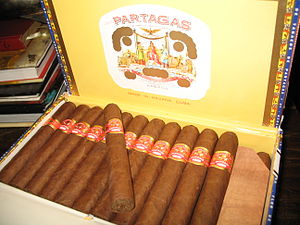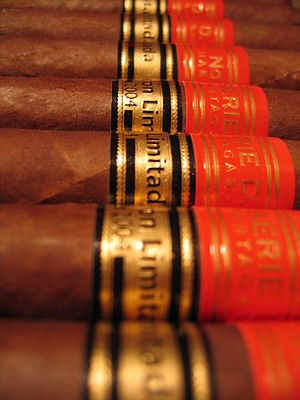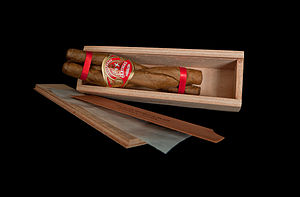- Partagás (cigar brand)
-
Partagás is among the oldest extant brands of cigars, established in Havana in 1845. The name is used today by two independent and competing entities, one produced on the island of Cuba for Habanos SA, the Cuban state-owned tobacco company, and the other produced in the Dominican Republic for the General Cigar Company, which is today a subsidiary of Swedish Match.
Contents
Cuban Partagás
History
The Spaniard Don Jaime Partagás y Ravell had worked in the Cuban tobacco business for years before establishing his own factory, Real Fábricas de Tabaco Partagás in 1845, on 60 Industria Street in Havana, one of the largest of its time. The name, which translates as "Partagás Royal Tobacco Factory," was supposedly chosen because of Don Jaime's status as cigar supplier to various European and Asian nobility. Don Jaime owned many of the best plantations in the Vuelta Abajo tobacco-growing region of Cuba and being able to choose from among the finest tobaccos on the island made the brand incredibly successful. Don Jaime is also believed to have experimented with various methods of fermenting and aging tobacco and is legendarily credited with hiring the first lector to read to and entertain the cigar rollers as they worked.
Don Jaime was murdered (supposedly by a jealous rival he'd been vying with in one of his love affairs) on one of his plantations in either 1864 or 1868 and his son José Partagás took over the business. Later on, the factory and brand were sold to a banker named José A. Bance, who in turn sold it to the firm of Cifuentes, Fernández y Cía in 1900. In 1916, Don José Fernández seems to have left the firm and Ramón Cifuentes Llano joined with Francisco Pego Pita to form the new firm of Cifuentes, Pego y Cía. In 1927, the firm would acquire the rights to the Ramón Allones brand and at some unknown point the factory began to produce a brand named for its owner, Cifuentes.
Cifuentes died in 1938 and Pego in 1940, leaving the Cifuentes family solely in control of the increasingly prestigious factory and brand (it's unknown why Pego's heirs didn't claim anything) and renaming the company simply Cifuentes y Cía. In 1954, the Cifuentes family acquired the Bolívar and La Gloria Cubana brands from José F. Rocha and moved their production to their factory. In 1958, the Partagás Factory was the second largest exporter of Cuban cigars (the H. Upmann Factory being the only one bigger), accounting for over a quarter of all exported tobacco goods.
Before and after the Revolution, the Cuban-produced Partagás has been one of the most revered and highest-selling brands of cigars in the world. By the middle 1990s the brand had become the second leading selling Cuban brand, following Montecristo, with annual sales of approximately 10 million cigars.[1]
The old Partagás Factory in Havana, since renamed the "Francisco Pérez Germán" factory, is still responsible for much of the annual production of the Partagás brand and has proven to be a very popular tourist destination for cigar smokers vacationing in Cuba.[1]
In 2002, when Altadis bought a controlling share in the Cuban government-owned cigar distributor, Habanos SA, a number of changes in cigar production were instituted. One of these changes was the decision to gradually turn the various brands of Cuban cigars to either all-handmade or all-machine-made lines, reduce the number of redundant sizes within a brand, and cut many low-selling cigars from production. Partagás, which has historically produced a variety of handmade and machine-made or machine-finished cigars, had several of its vitolas cut from production, much to the dismay of connoisseurs worldwide.
Since the introduction of the Edición Limitada annual releases, Partagás has gotten a special size made almost every year: the Pirámide in 2000, the Serie D No. 3 in 2001, the Serie D No. 2 in 2003, the Serie D No. 1 in 2004, a reissue of the Serie D No. 3 in 2006, and the Serie D No. 5 in 2008. In 2005, Partagás introduced a new addition to its regular lineup, a pyramid called the Serie P No. 2. So far, this new size has proved incredibly popular with cigar connoisseurs.
Partagás also produces two machine-made cigarillos (the Mini and the Club) and a brand of cigarettes.
Vitolas in the Partagás Line
The following list of vitolas de salida (commercial vitolas) within the Partagás marque lists their size and ring gauge in Imperial (and Metric), their vitolas de galera (factory vitolas), and their common name in American cigar slang.
Hand-Made Vitolas
- 898 Cabinet Selección Varnished - 6 3/4" x 43 (171 x 17.07 mm), Dalia, a lonsdale
- Aristocrat - 5 1/8" x 40 (130 x 15.88 mm), Petit Cetro, a petit corona
- Corona Junior - 4 5/8" x 40 (117 x 15.88 mm), Coronita, a petit corona
- Corona Senior - 5 1/4" x 42 (133 x 16.67 mm), Eminente, a corona
- Culebras - 5 3/4" x 39 (146 x 15.48 mm), Culebras, a culebra
- Habanero - 4 7/8" x 39 (124 x 15.48 mm), Belvedere, a short panetela
- Lusitania - 7 5/8" x 49 (194 x 19.45 mm), Prominente, a double corona
- Mille Fleurs - 5 1/8" x 42 (130 x 16.67 mm), Petit Corona, a petit corona
- No. 1 - 6 3/4" x 43 (171 x 17.07 mm), Dalia, a lonsdale
- Partagás de Luxe - 5 1/2" x 40 (140 x 15.88 mm), Crema, a corona
- Petit Corona Especial - 5 1/4" x 42 (133 x 16.67 mm), Eminente, a corona
- Presidente - 6 1/4" x 47 (159 x 18.65 mm), Taco, a perfecto
- Princess - 5" x 35 (127 x 13.89 mm), Conchita, a short panetela
- Serie du Connaisseur No. 1 - 7 1/2" x 38 (191 x 15.08 mm), Delicado, a long panetela
- Serie du Connaisseur No. 2 - 6 1/2" x 38 (165 x 15.08 mm), Parejo, a panetela
- Serie du Connaisseur No. 3 - 5 5/8" x 35 (143 x 13.89 mm), Carlota, a panetela
- Serie D No. 4 - 4 7/8" x 50 (124 x 19.84 mm), Robusto, a robusto
- Serie P No. 2 - 6 1/8" x 52 (156 x 20.64 mm), Pirámide, a pyramid
- Short - 4 3/8" x 42 (111 x 16.67 mm), Minuto, a petit corona
- Super Partagás - 5 1/2" x 40 (140 x 15.88 mm), Crema, a corona
Edición Limitada Releases
- Pirámide (2000) - 6 1/8" x 52 (156 x 20.64 mm), Pirámide, a pyramid
- Serie D No. 3 (2001/re-release in 2006), - 5 5/8" x 46 (143 x 18.26 mm), Corona Gorda, a grand corona
- Serie D No. 2 (2003) - 6 1/8" x 50 (156 x 19.84 mm), Doble, a robusto extra
- Serie D No. 1 (2004) - 6 3/4" x 50 (171 x 19.84 mm), Partagás No. 16, a double robusto
- Serie D No. 5 (2008) - 4 1/3" x 50 (110 x 19.84 mm), Serie D No. 5, a petit robusto
General Cigar Company's Partagás
After tobacco was nationalized following the Cuban Revolution, the Cifuentes family's patriarch, Ramón, was initially offered the job of leading Cuba's tobacco industry, but refused and instead emigrated from the country. A newly formed government marketing agency, Cubatabaco, took over the Partagás factory and the production of the brand there.
After a hiatus of almost seventeen years, the patron of the family, Ramón Cifuentes licensed the names Partagás and Bolívar cigars to the General Cigar Company, which in 1978 obtained a trademark and relaunched the brand for the lucrative American market.[1] Initial production took place in Jamaica, but the following year production of the revisited brand moved to a modern factory in Santiago, capital of the Dominican Republic.[1]
In 1995 the 70,000-square-foot (6,500 m2) Santiago facility employed approximately 600 workers, who produced cigars bearing both the Partagas and Macanudo labels.[1] Approximately 8 million Partagas cigars were produced by General Cigar Dominicana in that year.[1]
A similar trade dress to the Cuban product has been used by General Cigar for its competing version of the Partagás brand, employing a red-and-gold band scheme, save with the word "Habana" replaced by the date "1845" on the packaging.[1]
Footnotes
Further reading
- Min Ron Nee, An Illustrated Encyclopaedia of Post-Revolution Havana Cigars. Hong Kong: Interpro Business Corp., 2003.
External links
See also
Categories:- Cigars
- Habanos S.A. brands
Wikimedia Foundation. 2010.



